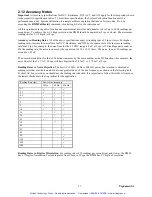
3.6 Using the Control Panel
Figure 3-2
.
The Control Panel for the SMX2044. The three main groups include Measure, Source and
ange buttons. The 8 Range buttons are context sensitive such that only “330m, 3.3, 33 and 250 appear
R
when in AC Voltage Functions, “3.3m 33m 330m 2.5” appear when in Current Functions, etc.
Note: All of the controls described below correspond to their respective software function, which can be invoked
within your control software or as objects in a visual programming environment. Using the software command
language of the SMX2040 provides powerful capabilities. Some composite functions are not included in the control
panel above.
DC/AC
This function switches between DC and AC. This is applicable for the following DMM functions:
Voltage, Current, and Voltage-Source. If Voltage-Source is the function presently in use, the Source control under
the Tools
menu can be used to set frequency and amplitude in ACV, and amplitude only in DCV and DCI.
Relative
This is the Relative function. When activated, the last reading is stored and subtracted from all
subsequent readings. This is a very important function when making low level DCV measurements, or in 2W
Ω
. For
example, when using 2W
Ω
, you can null out lead resistance by shorting the leads together and clicking on
Relative.
When making low level DC voltage measurements (e.g., in the
µ
V region), first apply a copper short to the
V,
Ω
+
&
-
input terminals, allow the reading to stabilize for a few seconds, and click on
Relative
. This will correct for any
offsets internal to the SMX2040. The
Relative
button can also be used in the Percent and dB deviation displays
hown below), which are activated using the
Tools
in the top menu.
(s
Signametrics
22
Rate Box
Controls the SMX2040 reading rate. 0.1 rps to 1,000 rps can be set. As measurement rate increases, so
does the measurement noise. For best accuracy set to the lowest rate acceptable for the application. Also consider
the line frequency (50/60 Hz) of operation when setting reading rates, as certain reading rates have more noise
rejection at either 50 or 60 Hz. (See “Specifications” for details.) Generally, set the measurement rate to as low a
rate as practical for the application. When measuring RMS values, there is no point setting the measurement rate to
a value higher than 5 rps since the RMS circuitry has a settling time that is over a second.
The capacitance and
inductance functions are not affected by rate setting.
Note on Measurement Rate: All three products are capable of continuous measurement as well as data transfer
rates of up to 1,000 rps. To achieve the 6-1/2 digit resolution and accuracy, the DMM should be operated at 10 rps
or slower. The maximum reading rate for 5-1/2 digits is 30 rps.
The Min/Max box can be used to analyze variations in terms of Min, Max, Percent and
dBV. This display can be activated by selecting the Min/Max/Deviation from the Tools
menue. For instance, testing a circuit bandwidth with an input of 1V RMS, activate t
Relative function with the frequency set to 100Hz, than sweep gradually the frequency
and monitor the percent deviation as well as the dBV error and capture any response
anomalies with the Min/Max display. The left display indicates peaking of 2.468%
(0.21 dBV) and maximum
he
,
peaking in the response of +56.24mV and a notch of –
10.79mV from the reference at 100Hz.
Artisan Technology Group - Quality Instrumentation ... Guaranteed | (888) 88-SOURCE | www.artisantg.com
















































